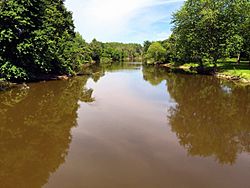Bad River (Michigan) facts for kids
Quick facts for kids Bad River |
|
|---|---|

The Bad River in St. Charles
|
|
| Country | United States |
| State | Michigan |
| Counties | Gratiot, Saginaw |
| Physical characteristics | |
| Main source | Newark Township 43°14′29″N 84°38′23″W / 43.24142°N 84.63972°W |
| River mouth | Shiawassee River Shiawassee National Wildlife Refuge 43°19′25″N 84°05′22″W / 43.32363°N 84.08942°W |
| Length | 44.3 mi (71.3 km) |
The Bad River is a river located in the state of Michigan, United States. It stretches for about 44.3 miles (71.3 kilometers). This river starts in Gratiot County and flows towards the northeast. It eventually joins another river called the Shiawassee River within the special area known as the Shiawassee National Wildlife Refuge.
Contents
Exploring Michigan's Bad River
The Bad River is an important waterway in central Michigan. It might have a name that sounds a bit unusual, but it plays a big role in the local environment.
Journey of the Bad River
The Bad River begins its journey in Newark Township. This area is near the city of Ithaca in Gratiot County. From there, the river flows in a north-easterly direction.
As it travels, the river enters Saginaw County. It then passes through the village of St. Charles. Finally, the Bad River empties into the Shiawassee River. This meeting point is inside the Shiawassee National Wildlife Refuge.
How Big is the River System?
The Bad River itself is about 44.3 miles (71.3 kilometers) long. But it's not alone! Many smaller streams and creeks flow into the Bad River. These are called its tributaries.
When you add up the length of the Bad River and all its tributaries, the total is about 175 miles (282 kilometers). That's a lot of flowing water!
The River and Its Surroundings
Most of the land around the Bad River is used for farming. About 86.5 percent of the land in the river's watershed is agricultural. A watershed is the area of land where all the water drains into a particular river or lake.
Because so much of the land is used for farming, the river system has been affected. For example, much of the river has been channelized. This means parts of the river have been straightened or deepened by people. This is often done to help with drainage for farms.
The river has also been impacted by sedimentation. This happens when soil and other small particles wash into the river. This can make the water cloudy and affect the plants and animals that live there. Scientists and local groups often work to help keep the river healthy.

